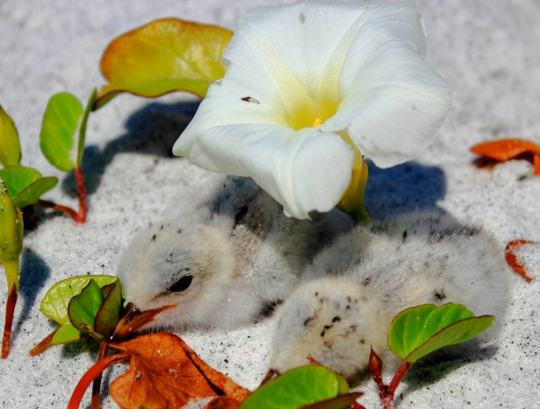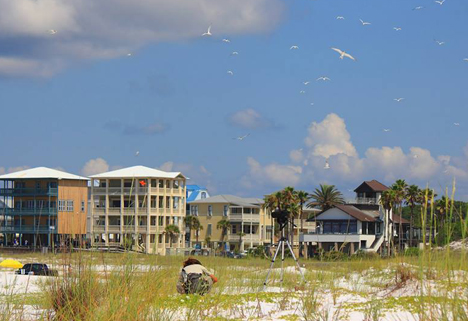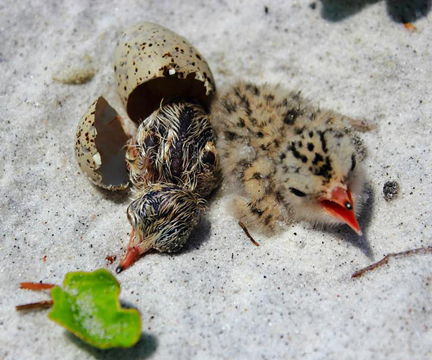
Be mindful and respect wildlife this coming holiday weekend and every day
By Jeff Talbert, Park Services Specialist
Topsail Hill Preserve State Park
Each year on our beaches, imperiled animals come to nest. Many visitors and residents are aware of our nesting sea turtles and even our endangered beach mice. However, most aren’t aware of our nesting shorebirds. Each year Okaloosa, Walton, and Bay County beaches play host to a variety of nesting shorebirds including snowy plovers and least terns. These two bird species are listed as threatened in the state of Florida which means their numbers are dwindling. They have been forced into smaller and smaller areas as their habitat has been transformed into housing and recreation areas. The fate of each nest is critical to the survival of these birds in Florida. Fortunately preserved areas serve as nesting grounds and affords these birds a chance at successful nesting, which will ultimately help their populations to rebound. Topsail Hill Preserve, Grayton Beach, Deer Lake, Camp Helen, and St. Andrews State Park (mainland and Shell Island) all serve as important nesting sites and all have had record nesting this year. Yet it is important to make others aware that these species are nesting on our local beaches so that disturbances can be minimized in the protected areas. Especially since the largest nesting colony at Grayton Beach is immediately adjacent to a heavily used public driving area.

Least terns are colony nesters, which means they find protection in large numbers. It is easier for them to fend off potential predators when there are a large amount of birds. Nesting on the beach can be a daunting task and the predators have the advantage. Coyotes, foxes, raccoons, laughing gulls, gull billed terns, humans, and even domesticated dogs all can cause colony collapse. The snowy plovers on the other hand, are solitary nesters and rely on camouflage and theatrics to protect their nests. Currently this year at Grayton Beach there are nearly 200 nests, over 50 chicks, all from approximately 300 birds and that is just the least terns. There have been eight snowy plover nests so far and of those five chicks have fledged and another seven chicks are expected in the coming weeks. This is the most nesting that has been seen at this park since the Florida Park Service has been keeping records. Park biologists and staff have been working diligently to ensure the success of this colony.
This is where you come in; the success of this colony and these birds rests upon public awareness. The public driving portion of Grayton Beach is a very popular place during the 4th of July and it just so happens that it coincides with the bulk of the nest hatchings within the colony. Due in part, to a public outreach effort, the large crowds this year have been aware and the impact to nesting shorebirds has been very minimal.

Our main concern is the large crowds and the use of fireworks associated with the 4th. Fireworks and nesting shorebirds do not mix; they can cause confusion, panic, and leave flightless chicks without protection. Fireworks launched towards the park and into the nesting colonies may even cause nest/chick abandonment or colony abandonment. In order to help us protect these birds we simply ask that you not shoot fireworks into the park, keep your dogs on a leash and out of the park (where they aren’t allowed), and do not cross any rope barriers that are established to protect colonies. You will immediately know when you have ventured into an area that you shouldn’t by the sight of nearly 300 birds swirling about and diving at you. There has been a large time investment by park staff ensuring the success of this year nesters and we need your help for that success to continue. These simple steps will help as you are enjoying our beautiful beaches.
- KEEP YOUR DISTANCE– If birds become agitated and leave their nests then you are too close, this also leaves their eggs and chicks vulnerable to predators and the summer heat.
- RESPECT POSTED AREAS– Nests are camouflaged and blend in with the sand thus making them hard to see. Walking or allowing your dog to roam in roped off areas puts nest at risk of being trampled. This also applies to the air over roped off areas, shooting fireworks, flying remote controlled planes, or flying a parasail over protected areas creates a disturbance and will chase birds away.
- NEVER INTENTIONALLY FORCE BIRDS TO FLY– Birds come to our beaches to rest just like we do. When we scatter a group of birds they have to use energy that they need to reserve for nesting activities or migration. While it creates a great visual it is the same as someone chasing you as soon as you sit down on the beach.
- KEEP PETS ON A LEASH AND AWAY FROM NESTING AREAS– While it is probably true that your particular dog doesn’t chase birds, nesting shorebirds can’t distinguish a good dog from a predatory dog they just assume all canines are predatory and react as such. Two of their main predators are canines, such as coyotes and fox. They will flush off of their nest when approached by anything resembling a threat putting eggs and chicks at risk; this includes your dog no matter how well behaved. In Walton county dogs are allowed on the beach at certain times with a proper permit. They are not allowed at anytime to be off a leash or on the state park beaches.
- KEEP THE BEACH CLEAN AND DO NOT FEED WILDLIFE– Food scraps attract predators such as raccoons and fish crows to the beaches. Fishing line and other litter poses a threat to flightless chicks. It is against the rules to feed wildlife in the state park not to mention it is impolite to your beach neighbors to attract seagulls with snacks. They will eat anything and don’t know when to go away.
- SPREAD THE WORD– If you see people disturbing the nesting birds please let them know how they may be affecting bird’s survival or contact the Grayton Beach State Park office at 850-267-8300, the Walton County Sheriffs Office at 850-892-8111, or FWC at 888-404-3922.
Please help us give these birds a chance at survival.
